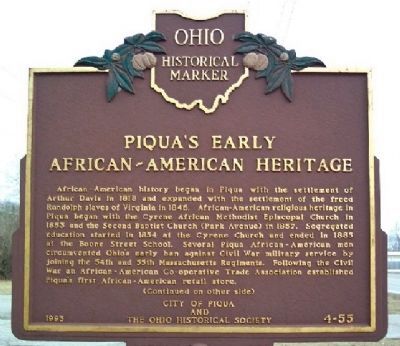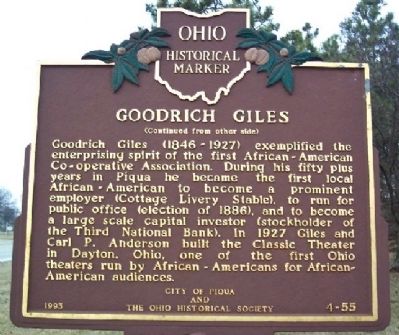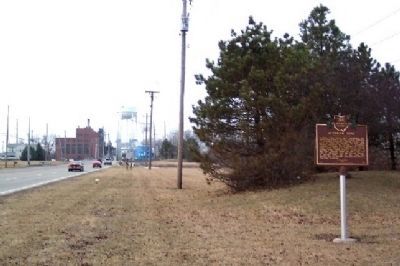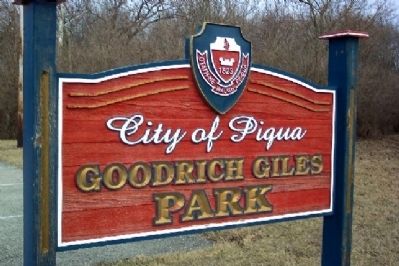Piqua in Miami County, Ohio — The American Midwest (Great Lakes)
Piqua's Early African-American Heritage
Inscription.
Side A: Piqua's Early African-American Heritage
African-American history began in Piqua with the settlement of Arthur Davis in 1818 and expanded with the settlement of the freed Randolph slaves of Virginia in 1846. African-American religious heritage in Piqua began with the Cyrene African Methodist Episcopal Church in 1853 and the Second Baptist Church (Park Avenue) in 1857. Segregated education started in 1854 at the Cyrene Church and ended in 1885 at the Boone Street School. Several Piqua African-American men circumvented Ohio's early ban against Civil War military service by joining the 54th and 55th Massachusetts Regiments. Following the Civil War an African-American Co-operative Trade Association established Piqua's first African-American retail store.
Side B: Goodrich Giles
Goodrich Giles (1846-1927) exemplified the enterprising spirit of the first African-American Co-operative Association. During his fifty plus years in Piqua he became the first local African-American to become a prominent employer (Cottage Livery Stable), to run for public office (election of 1886), and to become a large scale capital investor (stockholder of the Third National Bank). In 1927 Giles and Carl P. Anderson built the Classic Theater in Dayton, Ohio, one of the first Ohio theaters run by African-Americans for African-American audiences.
Erected 1993 by City of Piqua and The Ohio Historical Society. (Marker Number 4-55.)
Topics and series. This historical marker is listed in these topic lists: African Americans • Churches & Religion • Education • Entertainment • Government & Politics • Industry & Commerce • War, US Civil. In addition, it is included in the African Methodist Episcopal (AME) Church, and the Ohio Historical Society / The Ohio History Connection series lists. A significant historical year for this entry is 1818.
Location. 40° 7.77′ N, 84° 14.148′ W. Marker is in Piqua, Ohio, in Miami County. Marker is on Main Street, on the right when traveling north. Marker is at Goodrich Giles Park, about 1/3 mile south of the power plant. Touch for map. Marker is in this post office area: Piqua OH 45356, United States of America. Touch for directions.
Other nearby markers. At least 8 other markers are within 2 miles of this marker, measured as the crow flies. The Village of Huntersville (approx. 1.1 miles away); Vice Admiral Stephen Clegg Rowan (approx. 1.1 miles away); Shawnee Bridge (approx. 1.1 miles away); Main Street (approx. 1.2 miles away); The 1913 Flood (approx. 1.2 miles away); Public Square (approx. 1.2 miles away); Lock Nine (approx. 1.2 miles away); Lock Nine Riverfront Park (approx. 1.3 miles away). Touch for a list and map of all markers in Piqua.
Credits. This page was last revised on June 16, 2016. It was originally submitted on March 18, 2009, by William Fischer, Jr. of Scranton, Pennsylvania. This page has been viewed 1,641 times since then and 67 times this year. Photos: 1, 2, 3, 4. submitted on March 18, 2009, by William Fischer, Jr. of Scranton, Pennsylvania. • Craig Swain was the editor who published this page.



